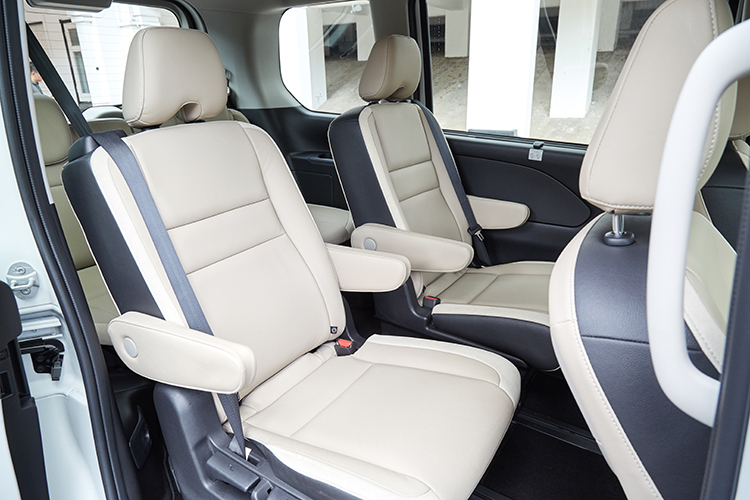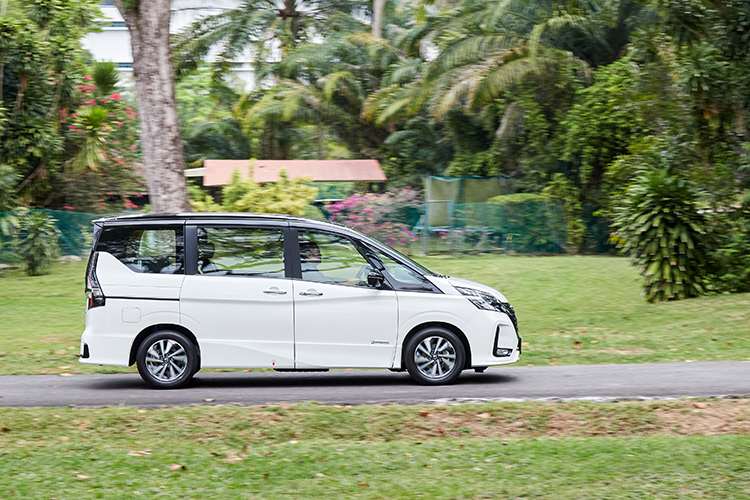
Nissan Serena e-POWER.
Big and boxy seven-seater MPVs weren’t always welcome in my book.
Brick-like and slab-sided, they looked ungainly and boring to drive. Which enthusiast in his or her right mind would want one?
But after I had driven my first Toyota Alphard, I realised (somewhat shamefully) that I had been judging these books by their covers.
Their square bodies made them supremely spacious. Captain’s chairs in the second-row (some with ottoman footrests), made it feel like you were in business class.
And when you’re stuck in traffic, it’s great to have all this lounging room to call your own. Provided you’re being chauffeured, of course.
So, does the Nissan Serena e-POWER live up to these expectations?

The Nissan Serena e-POWER is a seven-seater MPV with an electric drivetrain. But it is not a pure electric vehicle. It’s actually a hybrid.
This MPV is moved by an electric motor that draws power from lithium-ion batteries. However, the batteries are charged via a generator, which is actually a 1.2-litre petrol engine.
Therefore, you don’t have to plug the Serena e-POWER in to recharge it. You just pump petrol. This makes it convenient, because you don’t have to worry about finding a charging point.
When you first approach the Nissan Serena e-POWER, one thing becomes very clear: It has plenty of presence.
The Serena e-POWER’s large V-shaped grille and even larger front windscreen are impossible to ignore. Look around the Serena. When it comes to glass, this MPV has plenty of it.

Thanks to those big panes of glass, the Serena e-POWER’s cabin is bright and airy. Behind the wheel, the huge windscreen makes the already expansive one in the Citroen Grand C4 Spacetourer seem small.
I was pleased to see an uncomplicated dashboard. There’s no multitude of buttons to press, and the ones on the D-shaped steering wheel are intuitive enough.
However, the Serena e-POWER’s instrument panel is a hit-and-miss. I like its clarity and the animated graphics for the energy flow. On the other hand, I dislike how far it is from the driver. And its placement is odd. Between the centre and directly in front of the driver is not ideal.

That said, the Serena e-POWER’s cockpit is quite practical. Because the instrument panel is placed so far forward, there is extra space for two storage bins on top of the dashboard. In addition, there’s a glove box, and a compartment between the front seats.
Boxy MPVs are all about ferrying people and the Nissan Serena e-POWER excels in this field.
Executives (the boss’ subordinates) will find ingress and egress easy, thanks to the handsfree auto sliding doors. With the key in your pocket, all it takes is a kicking action below the vehicle to slide the doors open and close.

Inside, even 1.8m tall folks won’t have to stoop too low as the vertical space is 1.4m high. This makes moving around easy, especially if you’re in a suit.
For coffee or tea on-the-go, the Serena e-POWER’s second-row passengers get aircraft-style tray tables, each with two cupholders.
If you’re lower down the corporate ladder and have to sit in the Serena e-POWER’s third-row, you won’t feel punished. There’s plenty of legroom back here. My only beef is with the short backrests. Anyone taller than 1.6m will need to deploy the headrests.
Speaking of headrests, the one for the third-row’s middle occupant must be removed and stowed if you want to fold up the third-row seats.

Once folded up and to either side of the Serena e-POWER, the windows are not blocked, unlike say, in a Toyota Alphard. This improves visibility for when you’re hauling luggage.
The Nissan Serena e-POWER’s electric motor does a good job of hauling bags and ferrying folks.
Producing 134hp (136ps), it moves off the line fairly easily and delivers power progressively. The 320Nm of torque, which is instantly available and lasts till 2985rpm, helps in this regard.
The Nissan Serena e-POWER is not a sporty MPV. It takes something like 12 seconds (perhaps more) to go from rest to 100km/h. Anyway, the more important point here is that it performs seamlessly.
The Nissan Serena e-POWER has three selectable drive modes. Normal (the default one), ECO and Smart.

In Normal, the Serena e-POWER feels like a normal MPV – especially in terms of braking. That means regular effort when depressing the pedal.
In ECO and Smart modes, however, the regenerative braking is so strong that you can drive the car with one pedal. Basically, lifting off from the acclerator does most of the braking for you.
I drove the Serena e-POWER in Smart mode for most my two-day drive. ECO retards the power delivery so severely that other drivers probably accused me of being a road hog.

Ride comfort is another Serena e-POWER strong suit. With 16-inch wheels and comfort-biased tyres, the towkay and his team should feel less tired going from one meeting to another.
That’s another plus with an MPV. Bosses can have their key employees with them as they travel from one boardroom to another. The PA, corporate counsel, accountant and perhaps two bodyguards can easily tag along.
On the weekends, the Serena e-POWER resumes its duty as the family transporter. Nissan claims the MPV offers nine seating arrangements. So kids, in-laws and even the family pooch can all fit in here.
Big and boxy seven-seater MPVs are cool. And with the right drivetrain, they can be eco-friendly, too.

Nissan Serena e-POWER
ENGINE 1198cc, 12-valves, inline-3
ELECTRIC MOTOR AC Synchronous
MAX POWER 134hp at 2985-9867rpm
MAX TORQUE 320Nm at 0-2985rpm
GEARBOX Single-speed reduction gear
0-100KM/H 12 seconds (estimated)
TOP SPEED 145km/h
CONSUMPTION 18.5km/L (combined)
CO2 EMISSION 121g/km
PRICE INCL. COE From $140,300 (after $10k VES rebate)
AGENT Tan Chong Motor


















